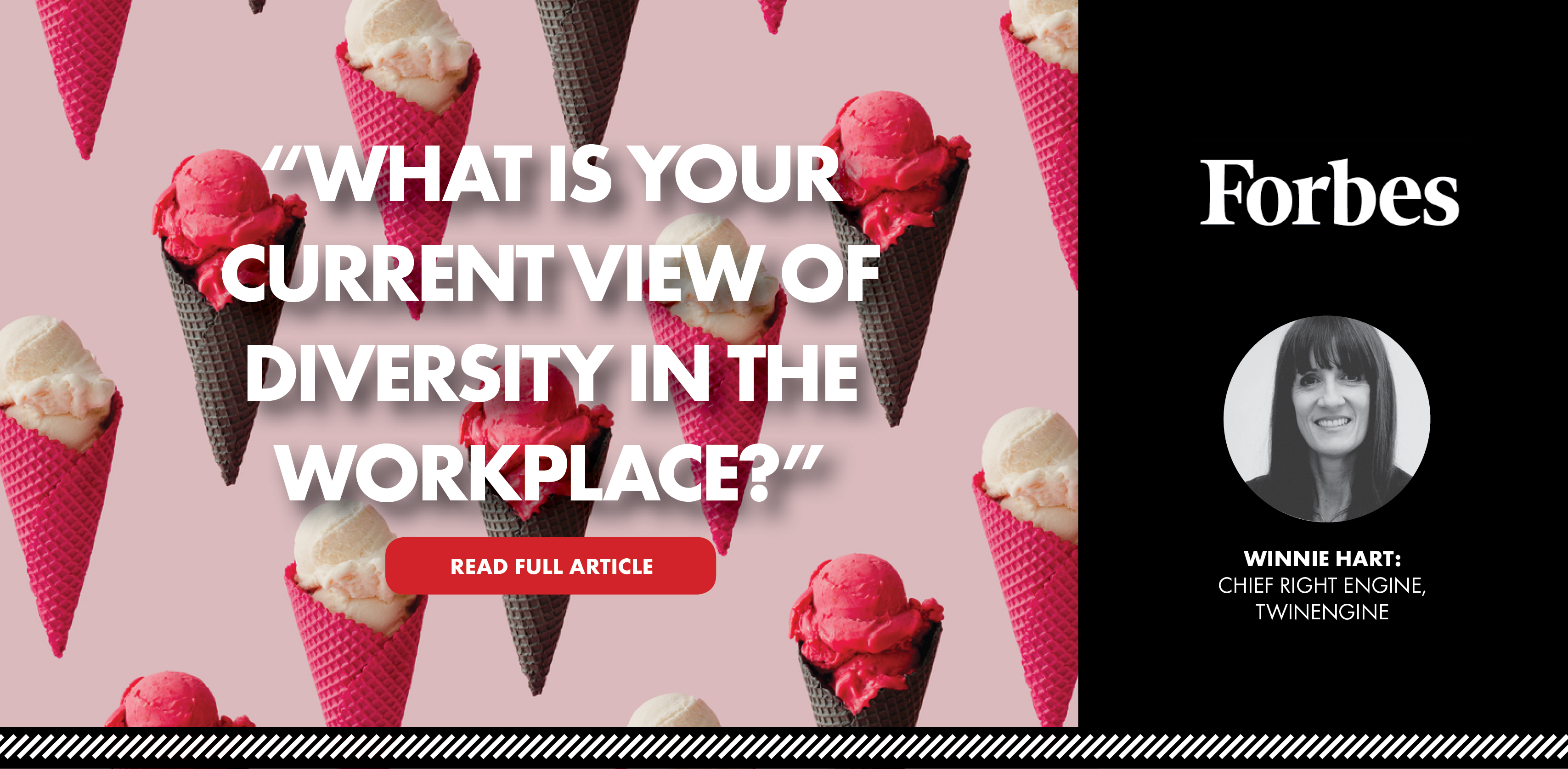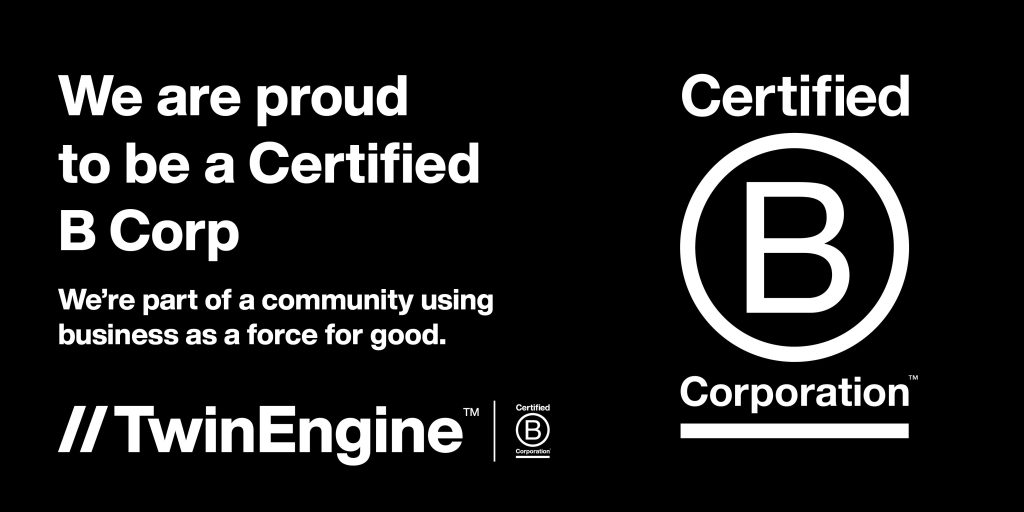(A reprint from a recent Forbes.com interview by Serenity Gibbons with Winnie Hart)
As building diverse workforces and diverse workplaces becomes more important, I want to profile business leaders who have been thoughtful and intentional in creating workplaces that embrace different people, needs, and skill sets.
This interview features Winnie Hart, the CEO of brand strategy firm TwinEngine and its monthly subscription brand kit, Brand in the Box, as well as the author of “Stand Out.” Focused on helping brands and organizations distinguish themselves from their competition and tell their stories, Houston-based TwinEngine uses its two engines — creativity and analytics — to propel them further.
Hart, who specializes in creative, has experience in a wide range of strategy disciplines, including everything from reputation management to content development. The past president of the Art Directors and Designers Association, Hart is the Women of EO Champion in Entrepreneurs’ Organization.
Serenity Gibbons: How has your entrepreneurial experience been impacted by being a minority?
Winnie Hart: My grandmother taught me to be a strong person first, a strong woman second. As a maritime welder during World War II, she proved she could do a man’s job — anyone’s job. She was strong. She was fearless. She got it done and never complained. Her tenacity and leadership taught me that being a woman is a competitive advantage, not a barrier of entry. When we’re expected to underachieve, we overachieve. When expected to fail, we prevail. We are strong. She helped me see that, when given the opportunity, we activate our ability to lead and to nurture and deepen relationships. My mother followed this same empowering belief, and they together made me the woman and entrepreneur I am today.
Gibbons: What barriers have you had to overcome along your journey?
Hart: At 6:10 a.m., Monday, Aug. 29, 2005, Hurricane Katrina made landfall in Louisiana. The levees broke, and more than 80 percent of the city was flooded with more than 224 billion gallons of water. I lost 75 percent of my business in a weekend. Before that day, I thought failure was the worst possible thing that could happen. It may sound like a cliché, but I learned what would become my mantra: from crisis comes opportunity. From failure, I learned resilience. From failure, I learned that a strong vision sees no barriers. The collapse of my Louisiana business forced me to align my business ambitions with my purpose. When your purpose is in alignment with what you stand for, you are connected to who you are meant to be. Jim Collins, in his book “Good to Great,” says, “What you stand for should be the basis for every decision and touchstone for all of your actions.” What you stand for shapes the impact you have on the world and makes the difference between building a company that is ordinary or extraordinary. So while I have no expectation of failure, should disaster strike again, I’ll know for certain that I have the power to come back.
Gibbons: How has your view of success been influenced by your background?
Hart: When I was 11 years old, my dad bought a four-seater twin-engine plane. It was his lifelong dream to fly. It all started with building small model airplanes. I watched my dad and brother fly them, crash them, fix them, fly them again, and crash them again. This venture evolved into actual flying lessons. Dad spent countless hours in flight training. It took years, and I still remember looking up from our front yard to watch Dad’s first flyover late one summer afternoon. He inspired me and taught me that anything is possible — you’ve got to learn to fly small planes before you can fly the big ones. He also taught me that success is earned daily, which has become my brand promise: “to earn my wings every day.”
Gibbons: What’s your current view of diversity in the workplace, and how has it evolved?
Hart: I am a member of Entrepreneurs’ Organization (EO), a networking organization that is predominantly men. Because the women in the organization wanted a forum to discuss issues of diversity with other women entrepreneurs, to share experiences and foster relationships among like-minded women, we created a group of female members (Women of EO) to do just that. Honestly, serving as a “Champion” for the Women of EO has taught me that while diversity may be about counting the numbers, inclusion is about making the numbers count. I went from seeing diversity as a form of representation in my company to seeing that diversity doesn’t work without inclusion — which brings people together, breaks down barriers, and leverages the whole as greater than the sum of its parts. Each individual’s unique perspective holds the potential for innovation and opportunity.
Gibbons: What responsibility, if any, do you feel leaders have regarding building diverse workplaces?
Hart: If leaders are accountable for the success of their enterprise, a clear understanding of what constitutes success has to come first. If it’s about selling a service or a product and generating revenue, diversity in the workplace may help by bringing in different perspectives, different backgrounds, etc. Diversity does unlock innovation. As leaders, it is our responsibility to nurture an environment where diverse perspectives come together freely to think outside the box and explore breakthrough ideas. But diversity does more than that. A truly successful enterprise is one that provides a rewarding work life for everyone involved. That means being and feeling valued and included. A diverse workplace provides a place for everyone.
Gibbons: As an entrepreneur, do you feel networking is impacted by diversity issues?
Hart: When I became a part of the Women of EO and the Women of EO Champion, I had no idea that this organization would transform me in ways that I could never have imagined. I became a part of a group of members who so passionately care, not only about their personal and professional growth, but mine as well. We are not just women, but a highly diverse group of women from many backgrounds, with many different cultures, histories, abilities, strengths, and goals, yet we all share a passion for promoting diversity and inclusion in the environments we can influence. For many of us, true diversity was either undervalued or just plain absent where we came from. Our common ground is to change that.
Gibbons: If you could go back and talk to the child version of yourself, what would you say to prepare yourself for your entrepreneurial journey?
Hart: You are a brand; start building it early. I would tell myself to align who I am on the inside with how I present myself on the outside. We have to be true to our authentic selves and create a consistent impression of who we are. Your brand is an intangible asset, yet possibly the most valuable one you’ll ever own. When your brand is aligned with your purpose, it pays you in dividends: greater success, higher salaries, and more fulfillment. When your brand is weak and out of alignment, it’s like driving a car when the wheels are out of alignment: It might get you where you want to go, and then again, it might not. Your brand is like an investment. It needs to have a strategy, goals, regular check-ups, and a maintenance program to stay strong and growing. With a strong brand, you will be unstoppable and the very best version of yourself. Grow your brand, and change the world.
Gibbons: What do you see the U.S. business landscape looking like in 10 years?
Hart: Artificial intelligence will bring superhuman performance to businesses. I look at Siri, Alexa, and Google Assistant today and can see the significant impact AI will have on our companies very soon. At the same time, as entrepreneurs, we are robot-proof. As AI becomes a part of our daily lives and work, entrepreneurs have the advantage of being creative, innovating and leading teams. Can AI become a valuable tool among others we have? Sure. In fact, I believe the soft skills, the culture, and the brand focus that women leaders embody will actually be amplified by technology. Like Henry Ford said, “If I had asked people what they wanted, they would have said faster horses.” We don’t know what we don’t know, as my dad always says. Imagine the possibilities!


